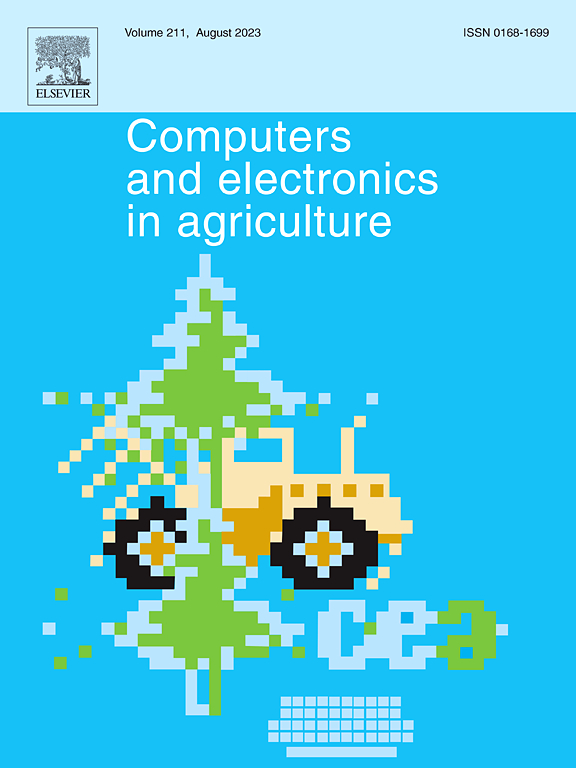Grapevine winter pruning: Merging 2D segmentation and 3D point clouds for pruning point generation
IF 8.9
1区 农林科学
Q1 AGRICULTURE, MULTIDISCIPLINARY
引用次数: 0
Abstract
Grapevine winter pruning is a labor-intensive and repetitive process that significantly influences grape yield and quality at harvest and produced wine. Due to its complexity and repetitive nature, the task demands skilled labor that needs to be trained, as in many other agricultural sectors. This paper encompasses an approach that targets using a robotic system to perform autonomous grapevine winter pruning using a vision system and artificial intelligence. In our previous work, we presented a 2D neural network that segmented images of grapevines into 5 different classes of plant organs during their dormant season. In this paper, we expand into the third dimension, introducing point clouds into our algorithm. The 3D approach creates instance-segmented point clouds using depth images and segmentation masks obtained with our 2D neural network. After the 3D reconstruction, the system extracts thickness measurement and uses agronomic knowledge to place pruning points for balanced pruning. The study not only delineates the integration of 2D and 3D methods but also scrutinizes their efficacy in pruning point identification. The real-world performance of the created system was evaluated and statistically analyzed on data collected during field trials in the winter pruning season 2022/2023, where the system was used in a potted vineyard to prune a set of test vines, where the positive success rate is 54.2%. Moreover, as one of the main contributions, the paper underscores a unique facet of adaptability, presenting a customizable framework that empowers end-users to fine-tune parameters according to the expected balanced pruning. This adaptability extends to variables such as the number of nodes to retain on pruned spurs and the preferred cane thickness, encapsulating the versatility of the 3D approach.
葡萄冬季剪枝:融合二维分割和三维点云生成剪枝点
葡萄冬季修剪是一个劳动密集型和重复性的过程,显著影响葡萄的产量和质量在收获和生产的葡萄酒。由于其复杂性和重复性,这项任务需要熟练的劳动力,需要经过培训,就像在许多其他农业部门一样。本文包含了一种方法,目标是使用机器人系统使用视觉系统和人工智能执行自主葡萄藤冬季修剪。在我们之前的工作中,我们提出了一个二维神经网络,该网络将葡萄藤在休眠季节的图像分割为5种不同类型的植物器官。在本文中,我们扩展到第三维,在我们的算法中引入点云。3D方法使用我们的2D神经网络获得的深度图像和分割蒙版创建实例分割的点云。三维重建后,系统提取厚度测量值,利用农艺知识定位剪枝点进行平衡剪枝。该研究不仅描述了二维和三维方法的整合,而且还审查了它们在剪枝点识别中的有效性。在2022/2023年冬季修剪季节的田间试验中,对该系统的实际性能进行了评估和统计分析,该系统在盆栽葡萄园中用于修剪一组测试葡萄藤,其积极成功率为54.2%。此外,作为主要贡献之一,本文强调了适应性的一个独特方面,提出了一个可定制的框架,使最终用户能够根据预期的平衡修剪来微调参数。这种适应性扩展到变量,如在修剪后的刺上保留的节点数量和首选的手杖厚度,封装了3D方法的多功能性。
本文章由计算机程序翻译,如有差异,请以英文原文为准。
求助全文
约1分钟内获得全文
求助全文
来源期刊

Computers and Electronics in Agriculture
工程技术-计算机:跨学科应用
CiteScore
15.30
自引率
14.50%
发文量
800
审稿时长
62 days
期刊介绍:
Computers and Electronics in Agriculture provides international coverage of advancements in computer hardware, software, electronic instrumentation, and control systems applied to agricultural challenges. Encompassing agronomy, horticulture, forestry, aquaculture, and animal farming, the journal publishes original papers, reviews, and applications notes. It explores the use of computers and electronics in plant or animal agricultural production, covering topics like agricultural soils, water, pests, controlled environments, and waste. The scope extends to on-farm post-harvest operations and relevant technologies, including artificial intelligence, sensors, machine vision, robotics, networking, and simulation modeling. Its companion journal, Smart Agricultural Technology, continues the focus on smart applications in production agriculture.
 求助内容:
求助内容: 应助结果提醒方式:
应助结果提醒方式:


